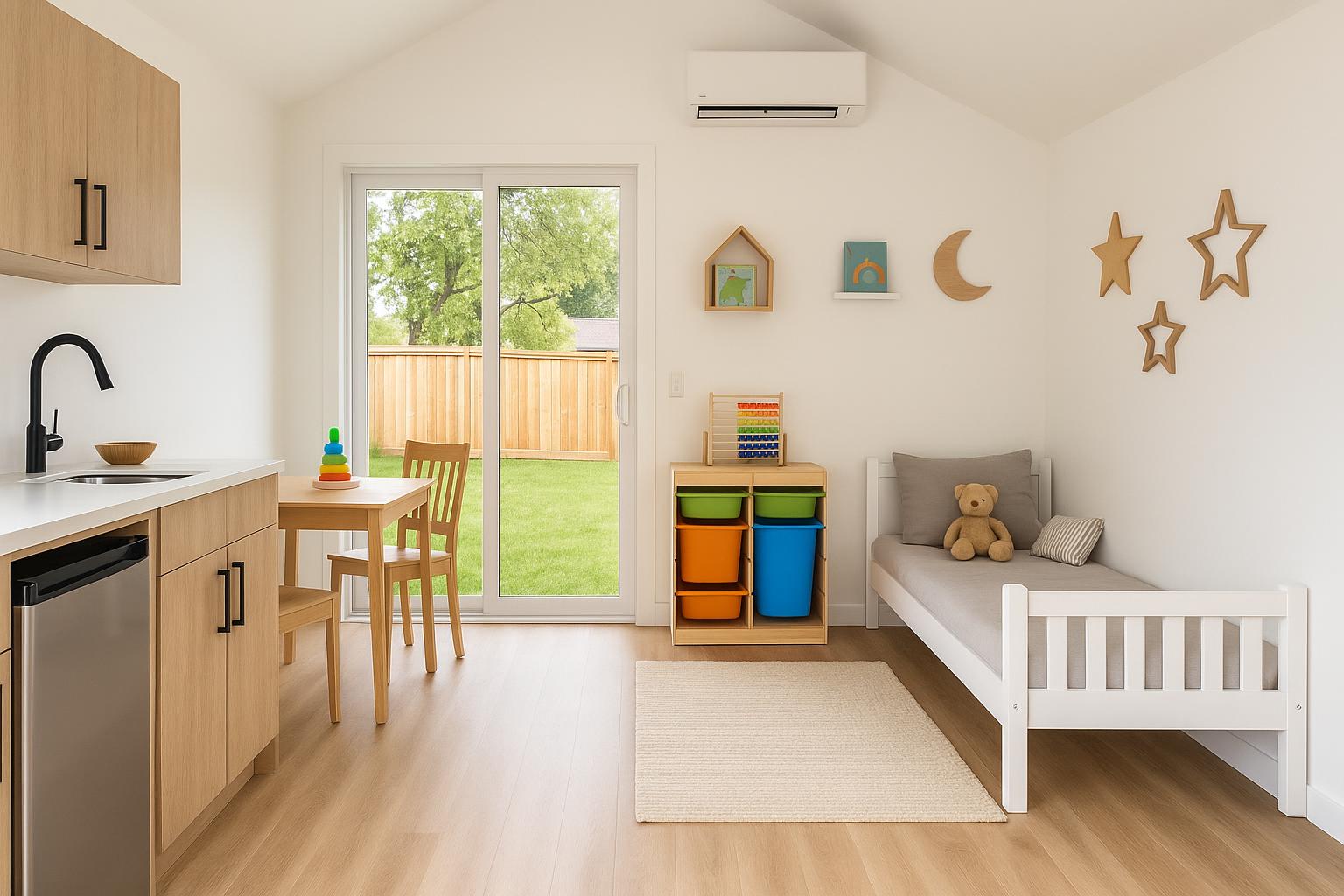
Maximizing Space and Safety: The Ultimate Guide to Kid-Friendly ADU Design in Canada
Estimated reading time: 8 minutes
Key Takeaways
- Innovative Design: Learn how kid-friendly ADU design transforms small spaces into functional and safe environments.
- Balanced Solutions: Understand the benefits and challenges of living in tiny homes and family ADUs.
- Practical Tips: Get actionable advice, checklists, and real-life Canadian examples to maximize both safety and play in every square centimetre.
Table of contents
- What Is Kid-Friendly ADU Design? A Practical Introduction
- Understanding Kids in Tiny Homes: Benefits and Challenges
- Core Principles of Kid-Friendly ADU Design
- Child Safety in Small Spaces
- Accessible Play and Play Space Ideas
- Incorporating Play Spaces in Family ADU Design
- Real-Life Inspiration: Canadian Success Stories
- Actionable Tips and Checklist
- Conclusion
- Frequently Asked Questions
What Is Kid-Friendly ADU Design? A Practical Introduction
*Kid-friendly ADU design* is more than fitting a child’s bed into a cozy corner. It’s a blend of smart planning and thoughtful problem-solving to ensure that children thrive in small accessory dwelling units (ADUs) and tiny homes. In Canada, interest in family ADU design is strong among families seeking more affordable, flexible living spaces that suit multigenerational households or provide a separate, functional area for kids.
Families venturing into kids in tiny homes living are discovering both exciting benefits and unique challenges. On the plus side, parents and children bond closer, manage simpler routines, and reduce their environmental footprint. On the challenging side, limited square footage can make for potential clutter, cramped play, and a constant battle for privacy—all while ensuring that child safety isn’t compromised.
As rising property costs push families to explore new housing strategies, kid-friendly ADU design has gained popularity across Canada—fuelled by a growing ADU and tiny home market tailored for family needs and local affordability solutions. Thoughtful, play-centric, and safe design is at the centre of this movement, helping Canadian families get the most out of every square centimetre in their homes. For more insights, visit ADU Friendly Neighbourhoods in Canada 2025 and The Future of the ADU Market in Canada.
Understanding Kids in Tiny Homes: Benefits and Challenges
Challenges for Kids in Tiny Homes
- Limited play space: Children need room to play, build, and grow—tiny homes require creative design to save space for these needs.
- Potential for clutter: Without proper storage planning, toys and household items can quickly fill every available corner.
- Privacy trade-offs: Balancing shared sleeping and living spaces means managing privacy along with togetherness.
- Child safety: With every inch crucial, the proximity of hazards from stairs to storage demands extra precautions.
Benefits for Family ADU Design
- Closer bonds: Families naturally spend more time together, encouraging conversation and shared activities.
- Simplicity and ease: A smaller, simpler lifestyle means less cleaning, fewer belongings, and smoother daily routines.
- Smaller environmental footprint: Reduced energy, water, and material usage promote a more sustainable lifestyle.
In Canada, the movement towards tiny homes and family ADU design is about making space work smarter—not necessarily bigger—for kids and the entire family. For additional guidance, check out this Tiny Home Living Guide.
Core Principles of Kid-Friendly ADU Design: Open Layouts, Multifunctional Spaces, and Adaptability
Designing a kid-friendly ADU means more than squeezing in an extra bedroom. Canadian families must focus on flexibility and child-centric solutions.
Open Layouts: Maximizing Space and Visibility
- Fewer walls create a sense of spaciousness and allow for better supervision.
- Clear sight lines make it easy to keep an eye on kids from central areas like the kitchen or living room.
- Avoid clutter by integrating built-in storage solutions such as benches with drawers beneath beds and large windows to boost natural light.
Multifunctional Spaces: Every Piece with a Purpose
- Utilize furniture that performs double duty—such as sofa beds, tables with storage, and toy chests that convert into play tables.
- Install wall-mounted desks or fold-down tables to expand work and play areas without overcrowding the floor.
- Incorporate soft seating that doubles as extra sleeping space for guests or grandparents.
Natural Light: Boosting Health and Mood
- Utilize large windows, skylights, or glass doors to bring in ample sunlight.
- Natural light enhances the feeling of spaciousness, supports healthy sleep cycles, and encourages active play.
Adaptability: Designs That Grow with Your Kids
- Invest in modular furniture like convertible bunk beds and extendable tables that adapt as children grow.
- Implement movable partitions or sliding walls to transform one large space into multiple functional areas.
- Use flexible storage options such as rolling bins and stackable containers to maintain tidiness while keeping toys accessible.
These core principles empower families to build spaces that are creative, open, and ready for both active play and peaceful moments. Discover more strategies at Canada’s Housing Design Catalogue and learn about modular furniture solutions.
Child Safety in Small Spaces: What Every Family Needs to Know
Child Safety Must-Haves
- Rounded edges: Opt for furniture with rounded or padded corners to minimize bumps and bruises.
- Secure storage: Lock away hazardous items such as toxic cleaning supplies, medications, and sharp tools in high or locked cupboards.
- Childproof windows and doors: Install safety locks, window restrictors, baby gates on stairs, and sturdy railings on lofts or bunk beds.
- Non-toxic materials: Select paints, flooring, and finishes that are certified non-toxic and low in VOCs to maintain a healthy indoor environment.
- Fire and emergency safety: Ensure proper installation of egress windows, smoke alarms, and ventilation according to Canadian building codes.
Meeting Canadian Building Safety Standards
- Adhere to the Ontario Building Code or National Building Code regarding doors, windows, ventilation, and fire exits.
- Always have new or renovated spaces inspected for electrical safety, smoke/CO₂ detectors, and secure stairways.
Double-check local regulations and choose materials and layouts that meet stringent safety guidelines. Additional information is available at Canadian ADU Regulations Guide and St. Catharines Pre-Approved ADU Designs.
Accessible Play and Play Space Ideas: Creativity in Compact Living
Maximizing Play—Even in Small Homes
- Fold-away play furniture: Consider wall-mounted tables for crafts, fold-down basketball hoops, or Murphy beds that reveal hidden toy storage when lifted.
- Modular play structures: Create small indoor climbing gyms with integrated storage cubbies or sliding ladder bookshelves for dual functionality.
- Convertible storage: Utilize ottomans or benches with hidden compartments to keep art supplies and games neatly out of sight.
- Outdoor play zones: If space permits, add a tiny fenced yard, mini sandbox, sensory path, or compact garden area while exploring landscaping ideas for ADUs in Canada.
The aim is to maintain an open, flexible play space that can be quickly tidied up and repurposed for other daily activities.
Incorporating Play Spaces in Family ADU Design: Practical Approaches
Strategies for Smart Integration
- Play nooks and window seats: Carve out cozy corners, window ledges, or under-stair alcoves for reading, crafts, and imaginative play, complete with built-in storage for quick clean-ups.
- Convertible spaces: Use Murphy beds or fold-up futons to transform playrooms into bedrooms as needed.
- Interactive learning zones: Install chalkboard or whiteboard panels on kitchen cabinets, low shelving for books and puzzles, and area rugs with hopscotch patterns for engaging play.
- Creative flooring: Choose durable, non-slip floors like cork or engineered wood that encourage safe, barefoot play throughout the living space.
Blending dedicated play areas with essential living zones ensures functionality and fun are equally prioritized. For further design inspiration, visit Tiny Home Kitchen Design in Canada and Minimalist Living Guide for Canada.
Real-Life Inspiration: Canadian Success Stories in Kid-Friendly ADU Design
Canadian Case Studies and Examples
- St. Catharines Pre-Approved Family ADUs: Many Canadian municipalities, like St. Catharines, offer pre-approved ADU plans with features such as ground-level access, open-plan living, and child-friendly play nooks. Learn more at St. Catharines ADU Designs.
- Federal Housing Design Catalogue: Canada’s new design standards emphasize accessibility, safety, and family functionality, featuring convertible bedrooms and flexible space dividers that easily accommodate kids, parents, and grandparents. For details, see Federal Government Housing Designs.
- Creative Family-Specific Solutions: Across Canada, families are incorporating unique features such as compact bunk rooms with built-in desks, outdoor mud kitchens for sensory play, and hidden toy storage beneath staircases.
These examples prove that with imaginative design and thoughtful planning, family ADUs can be both safe and joyful for every member of the household. Additional inspiration can be found at Canadian ADU Success Stories and Multigenerational Tiny Homes.
Actionable Tips and Checklist: Building Kid-Friendly ADUs in Canada
Kid-Friendly ADU Design Checklist
- Prioritize visibility: Design open living areas so that play zones are always visible from the kitchen and main spaces.
- Secure all hazards: Utilize locked cabinets and high shelving to store cleaning supplies, sharp objects, and tools.
- Maximize vertical space: Install wall shelves, stackable bins, and hanging organizers to keep floors clear.
- Use non-toxic, durable materials: Choose paints, flooring, and cabinetry that adhere to Canadian safety and sustainability standards. Learn more from the Canadian ADU Regulations Guide and Federal Housing Design Catalogue.
- Plan for growth: Invest in modular furniture and flexible layouts that evolve as your children grow.
- Consult your municipality: Reach out to local ADU programs for guidance, grants, and pre-approved family-friendly designs. More details can be found at St. Catharines ADU Programs.
- Always check permits and zoning: Confirm what is allowed in your area and follow the latest safety codes. Additional permitting tips are available at ADU Permitting Ontario Guide.
This checklist will help ensure that your family’s ADU is safe, fun, and sustainable. Explore more ideas on compact living and storage at Small Homes & Compact Living and Tiny Home Storage Solutions.
Conclusion: Designing for Happy, Safe, and Playful Kids in ADUs
Kid-friendly ADU design isn’t just a trend—it’s a necessity for Canadian families aiming to create safe, accessible, and joyful living spaces in tiny homes. By embracing creative layouts, robust safety features, multifunctional furniture, and dedicated play areas, parents and designers can transform limited spaces into environments where children play, learn, and thrive.
Ready to maximize your small family home? Adopt these actionable tips, consult local experts, and discover how thoughtful family ADU design can create a vibrant and secure future for your children. Learn more about Kid-Friendly Tiny Homes in Canada and Family-Friendly Tiny Homes Design.
Frequently Asked Questions
What is Kid-Friendly ADU Design?
Kid-friendly ADU design focuses on creating small living spaces that are both functional and safe for families with children. It emphasizes open layouts, multifunctional furniture, and flexible play areas that grow with your child.
How can I ensure my tiny home is safe for my kids?
Safety is achieved through careful planning—incorporate childproof features such as rounded furniture, secure storage for hazards, appropriate window and door locks, and non-toxic building materials that meet Canadian standards.
Are there benefits to living in an ADU with children?
Absolutely. Families often enjoy closer bonds, simpler lifestyles, and reduced environmental footprints. ADU living also encourages creativity in design and functionality, ensuring safe and adaptable spaces for both adults and kids.

Leave a Reply